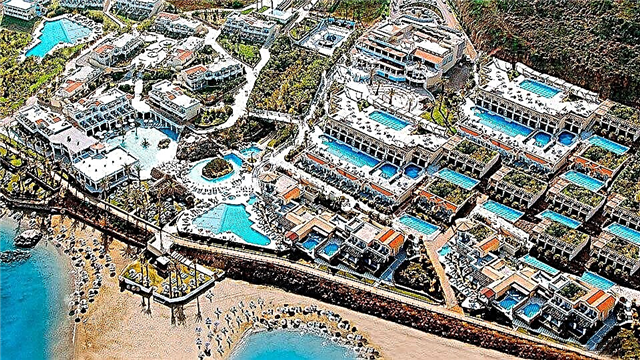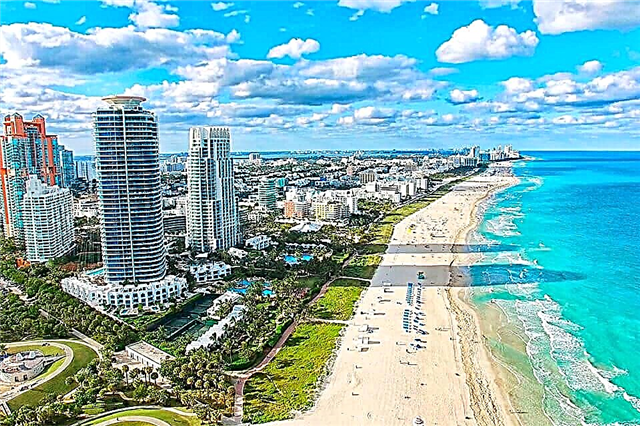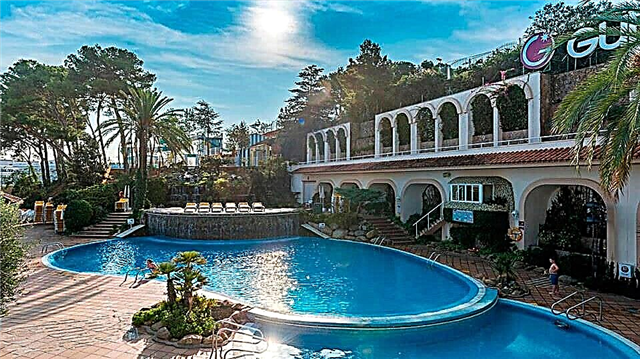Address: Russia, Nizhny Novgorod region, Nizhny Novgorod, Gordeevskaya street, 141
Start of construction: Smolensk Church: 1680, Vladimir Church: 1902
Completion of construction: Smolensk Church: 1697, Vladimir Church: 1907
Height to cross: 56 m.
Shrines: an icon with a reliquary cross and with particles of the relics of St. Sergius of Radonezh, an icon of St. Barnabas of Gethsemane, an icon of martyrs who suffered from the invasion of the Saracens
Coordinates: 56 ° 19'43.7 "N 43 ° 56'10.8" E
Content:
The harmonious ensemble of the Smolensk Church and the Vladimir Church is a real decoration of Gordeevka. A small Smolensk church appeared here at the end of the 17th century, as the house church of the salt industrialist Stroganov. And the majestic Vladimir Church was built nearby at the beginning of the 20th century. Both churches went through difficult trials, but today both believers and tourists have the opportunity to admire their beautifully decorated facades and rich interior decoration.

General view of the Smolensk-Vladimirsky parish from the side of the Smena cinema
The history of the construction of the Smolensk Church
The construction of the Smolensk Church is closely connected with the name of the famous Russian businessman and landowner Grigory Dmitrievich Stroganov (1656-1715). Salt brought great wealth to Stroganov, which was brought to the city along the Volga. Along the Volga bank, Stroganov owned rich stone courtyards. However, he settled his family in a quiet Gordeevka. This area was removed from the bustle of the port and the noise of the township bargaining.
At the end of the 17th century, the salt industrialist began building two churches in the city at once - the Nativity and Smolensk churches. This was the time when the magnificent baroque style, which came from Europe, came into fashion. And Stroganov felt and understood the new trends well. He was a well-educated person and subscribed to special publications on architecture from abroad.
Today in Russia there are only four churches built in the traditions of the Stroganov Baroque. All of them are unique and declared federal monuments. The buildings sponsored by Stroganov are distinguished by high reliability of structures, special thoroughness of decor and impeccable performance of all types of work. Stroganov always used the labor of the most skilled masons, carpenters and blacksmiths.
The construction of the Smolensk Church began in the 1680s. And he was destined to become the home church of the family of Grigory Stroganov. In the 1690s, the finished and finished church was consecrated. First - the side altar, and a little later, the main throne.
As was customary in home churches, the interior of the Smolensk Church was made small, because services were held here only for members of the Stroganov family and those who lived in the estate. The church building was built conscientiously. It had thick one and a half meter walls. For a long time, the exquisite external and internal decor made this temple one of the most beautiful in the city.

From left to right: Smolensk Church, Vladimirskaya Church
Grigory Stroganov was endowed with many talents, including a good taste in music. This is evidenced by the fact that Tsar Peter I asked the salt industrialist to send singers to the capital who sang in his Nizhny Novgorod house church.
At the beginning of the 18th century, major changes took place. The decree of Peter I introduced the state monopoly on the transport and trade of salt. In this regard, Grigory Stroganov lost economic interest in his Nizhny Novgorod possessions, and his family moved to live in Moscow. So, since 1705, the Smolensk church turned from a house house into a parish one.
The history of the construction of the Vladimir Church
From the end of the 17th century to the beginning of the last century, church services for the residents of Gordeevka were held in the Smolensk Church. However, it was very small and could not accommodate all those who came for prayer. Therefore, it was decided to build next to another, much larger temple. The project was commissioned by a young architect from St. Petersburg D.P. Fedorov. And information about the foundation stone of the future temple was published in the popular at that time weekly art and technical magazine "Zodchiy".
The Vladimir church was built with a three-altar and consecrated as soon as it was ready - from 1908 to 1909. The height of the building to the cross was 56 m. And the size of the church was inferior to only one Nizhny Novgorod temple - the Cathedral of Alexander Nevsky. The Vladimir temple turned out to be large, richly decorated and very convenient for conducting divine services. It was warm here, because steam boilers were placed in the basement of the building, and from them the heated air entered the rooms where the services were held.

View of the Smolensk Church from Gordeevskaya Street
When the church was completely ready, Father Fyodor (Milovsky), appointed by its priest, began to equip the belfry. He selected bell-ringers with an ear for music, and also organized a large choir in the new church, where adults sang, as well as a separate children's choir. Father Fyodor led a great educational work among the parishioners, helped the weak and the poor, talked about the dangers of alcoholism. The members of the church choir took part in performances in which they performed sacred music written by famous Russian composers - Tchaikovsky, Rachmaninov, Grechaninov and Bortnyansky.
Church parish during the years of Soviet power
In 1929, both churches were closed. And before that, they arranged a demonstrative discharge from the bell towers of all the bells. Initially, they wanted to adapt the Big Vladimir Church for a school or a club, but these plans were never realized. To give the cult building a more "civil" look, the upper part of the church along with the domes was destroyed by order of the local authorities. The beautiful temple was so disfigured that the Kanavino administration in 1934 took the initiative to demolish this building. However, specialists working in the regional museum of local lore opposed, and the church received the status of an architectural monument. The building of the Smolensk Church survived only due to the fact that a museum warehouse was located in it.
By the end of the 1940s, a bakery was opened in the long-suffering Vladimir Church. This production was located here for about half a century, and the church interiors were badly damaged due to the constant smoke.
New life of the Smolensk-Vladimir parish
The Smolensk Church was returned to believers in 1991. And the first restoration work and garbage collection were carried out by the parishioners themselves. Icons for the empty temple were also brought from homes. Two years later, the temple was consecrated.
Vladimirskaya church became a parish church a little later - in 1998. It took a lot of effort to clean the walls and ceilings of the accumulated soot, remove all the dirt and debris, and renovate the premises for worship. The restored church was consecrated in 2000.

View of the Vladimir Church from General Zimin Street
Architectural features of temples
The small and picturesque Smolensk Church is always light due to the fact that the windows on its southern facade are located in two rows. They are decorated with graceful ornamentation carved from light shell rock. The temple is crowned with five chapters, and the more massive middle bulbous chapter in size and height dominates the rest - helmet-shaped. On the west side of the church adjoins the building of the bell tower. Carefully forged metal crosses rise above the temple. It is known that master Kondraty Prokofiev, specially invited from Balakhna, supervised the blacksmiths who made these openwork crosses.
The Vladimirsky four-pillar temple was built in an eclectic style and combines the traditions of Old Russian architecture, Baroque and Art Nouveau. The tall building is completed by a light eight.And the unusual look of this church is given by expressive, large zakomars in the form of horseshoes. These unique zakomars, made in the Art Nouveau style popular at the beginning of the 20th century, are no longer found in the temple architecture of Nizhny Novgorod.
On three sides, the facades of the church are clearly divided horizontally into three parts. The lower tier is distinguished by arched window openings, framed by platbands with rustic decor. The most spectacular is the façade on the east side of the church building.
The current state of the temples and the visiting regime
Both churches are active today. Services are held here daily at 8.00 and 16.00. The parish is engaged in extensive educational activities. A Sunday school for parishioners' children is open at the churches. A squad named after Fyodor Ushakov has been organized for adolescents and young men. In addition, priests and parishioners work in the Nizhny Novgorod hospital No. 39 and contribute to the work of the volunteer movement, whose members help the needy and elderly citizens.
Currently (2016) the restoration of the facade of the Vladimir Church is underway.

View of the western facade of the Vladimir Church
How to get there
The parish churches are located in the Gordeevsky microdistrict, on Gordeevskaya street, 141. This place is located not far from the Moscow railway station and the Kanavinskaya bus station (1.1 km). The closest to the Smolensk and Vladimir churches can be reached by trams (stop "Smolensk Church").











